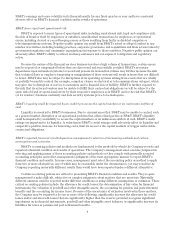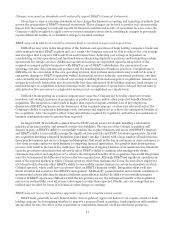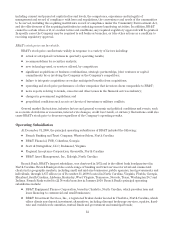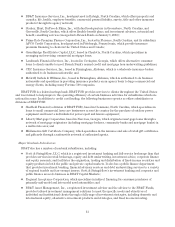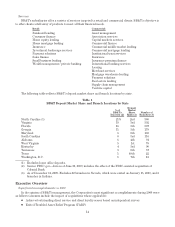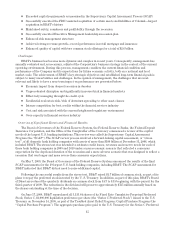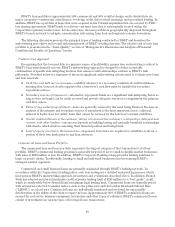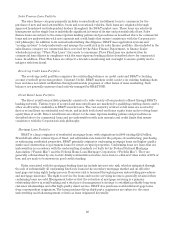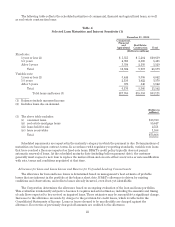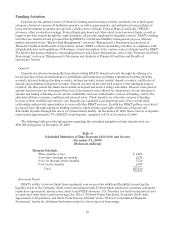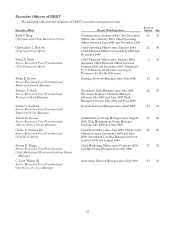BB&T 2009 Annual Report Download - page 19
Download and view the complete annual report
Please find page 19 of the 2009 BB&T annual report below. You can navigate through the pages in the report by either clicking on the pages listed below, or by using the keyword search tool below to find specific information within the annual report.BB&T’s loan portfolio is approximately 50% commercial and 50% retail by design, and is divided into six
major categories—commercial, sales finance, revolving credit, direct retail, mortgage and specialized lending. In
addition, BB&T has a portfolio of loans that were acquired in the Colonial acquisition that are covered by FDIC
loss sharing agreements. BB&T lends to a diverse customer base that is substantially located within the
Corporation’s primary market area. At the same time, the loan portfolio is geographically dispersed throughout
BB&T’s branch network to mitigate concentration risk arising from local and regional economic downturns.
The following discussion presents the principal types of lending conducted by BB&T and describes the
underwriting procedures and overall risk management of BB&T’s lending function. The relative risk of each loan
portfolio is presented in the “Asset Quality” section of “Management’s Discussion and Analysis of Financial
Condition and Results of Operations” herein.
Underwriting Approach
Recognizing that the loan portfolio is a primary source of profitability, proper loan underwriting is critical to
BB&T’s long-term financial success. BB&T’s underwriting approach is designed to define acceptable
combinations of specific risk-mitigating features that ensure credit relationships conform to BB&T’s risk
philosophy. Provided below is a summary of the most significant underwriting criteria used to evaluate new loans
and loan renewals:
ŠCash flow and debt service coverage—cash flow adequacy is a necessary condition of creditworthiness,
meaning that loans not clearly supported by a borrower’s cash flow must be justified by secondary
repayment sources.
ŠSecondary sources of repayment—alternative repayment funds are a significant risk-mitigating factor as
long as they are liquid, can be easily accessed and provide adequate resources to supplement the primary
cash flow source.
ŠValue of any underlying collateral—loans are generally secured by the asset being financed. Because an
analysis of the primary and secondary sources of repayment is the most important factor, collateral,
unless it is liquid, does not justify loans that cannot be serviced by the borrower’s normal cash flows.
ŠOverall creditworthiness of the customer, taking into account the customer’s relationships, both past and
current, with other lenders—our success depends on building lasting and mutually beneficial relationships
with clients, which involves assessing their financial position and background.
ŠLevel of equity invested in the transaction—in general, borrowers are required to contribute or invest a
portion of their own funds prior to any loan advances.
Commercial Loan and Lease Portfolio
The commercial loan and lease portfolio represents the largest category of the Corporation’s total loan
portfolio. BB&T’s commercial lending program is generally targeted to serve small-to-middle market businesses
with sales of $200 million or less. In addition, BB&T’s Corporate Banking Group provides lending solutions to
large corporate clients. Traditionally, lending to small and mid-sized businesses has been among BB&T’s
strongest market segments.
Commercial and small business loans are primarily originated through BB&T’s banking network. In
accordance with the Corporation’s lending policy, each loan undergoes a detailed underwriting process, which
incorporates BB&T’s underwriting approach, procedures and evaluations described above. In addition, Branch
Bank has adopted an internal maximum credit exposure lending limit of $245 million for a “best grade” credit,
which is considerably below Branch Bank’s maximum legal lending limit. Commercial loans are typically priced
with an interest rate tied to market indices, such as the prime rate and the London Interbank Offered Rate
(“LIBOR”), or a fixed-rate. Commercial loans are individually monitored and reviewed for any possible
deterioration in the ability of the client to repay the loan. Approximately 92% of BB&T’s commercial loans are
secured by real estate, business equipment, inventories and other types of collateral. BB&T’s commercial leases
consist of investments in various types of leveraged lease transactions.
19


